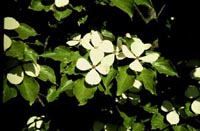Resource Library
Plant of the Week: Dogwoods, Celestial™
The University of Arkansas System Division of Agriculture does not promote, support or recommend plants featured in "Plant of the Week." Please consult your local Extension office for plants suitable for your region.
Plant of the Week
Celestial™ Dogwoods
Latin: Cornus x ‘Stellar® Series’

Now that I’m a grandparent, I hear lots of comments about who the babies look like. Perhaps hampered by poor imagination or even poor eyesight, I don’t always see the described resemblance, but it seems to be a grandparent’s calling in life to agree with all such proclamations.
When it comes to plants, I’m able to pick up on family resemblances a little more easily. One of the easiest to see is the dogwood hybrids developed between the Kousa Dogwood and our native Flowering Dogwood.
These spring flowering hybrids are a result of crosses made in the mid-1960's by Rutgers University plant breeder, Dr. Elwin Orton. So far, six trees have been released from the program, and most show more resemblance to momma, Cornus kousa, than the male parent C. florida.
The Celestial Dogwood, when 19 years old, was 17 feet tall and 14 feet wide with a distinctively vase-shaped habit of growth. With age, it will become more rounded in overall habit.
The white flowers, actually modified leaves called bracts, are tinged with green in the beginning and have the familiar overall shape of a dogwood bloom. But they show characteristics intermediate between the two parents. Instead of the sharp-pointed tip of the Chinese Dogwood, the blooms of Celestial Dogwood are rounded with only a slight point at the tip, but they lack the familiar notch of the Flowering Dogwood.
Bloom time is after the leaves appear and usually commences after the first week of May, about 3 weeks later than the native species blooms.
Orton, one of the few publicly supported ornamental plant breeders in the US, began his breeding program trying to increase the vigor of the dogwood to make it less susceptible to dogwood borer. This insect is capable of killing young, newly transplanted trees or older trees that have gone into a growth slump with age. His hybrids show increased vigor and are much more resistant to the pest than the native dogwood.
As a lucky happenstance, his dogwoods began to be released about the time that dogwood anthracnose (Discula) began killing older dogwoods up and down the East Coast. While not completely immune to the disease, the increased vigor of the hybrids makes them highly resistant under normal garden circumstances.
Celestial dogwood and its siblings have a longer pedigree than dogs shown in a New York Kennel Club competition. In the new world order where universities seek cash to support ongoing programs, a number of legalistic approaches are used to protect their property. First, the plant is patented (PI 7204) with the official cultivar name of "Rutdan," a name never used in any public forum discussing the plant.
Plant patents expire after 20 years. That’s often how long it takes for a new plant to be noticed in the nursery trade, so the university also trademarked the name Celestial, which can be renewed indefinitely. Originally they tried to trademark this plant as "Galaxy," but people at Rutgers must not drive Fords because Ford Motor Company has this name locked up.
Propagation agreements must be signed with the university to propagate the plant, even after the patent expires, and use the name Celestial.
From a cultural standpoint, the Celestial dogwood is grown similar to our native dogwood, but its hybrid vigor makes it less finicky about some of the cultural details. It’s best suited for planting in an area that has well drained soil and receives shade after 3 pm.
Like with all dogwoods, you want to make sure the plants are kept watered during droughts. But don’t overwater. The plant is ideally suited for use as a small specimen tree in the landscape, as a doorway planting near the entrance or near the patio where its blooms can be enjoyed in May.
By: Gerald Klingaman, retired
Extension Horticulturist - Ornamentals
Extension News - March 2, 2001
The University of Arkansas System Division of Agriculture does not maintain lists of retail outlets where these plants can be purchased. Please check your local nursery or other retail outlets to ask about the availability of these plants for your growing area.